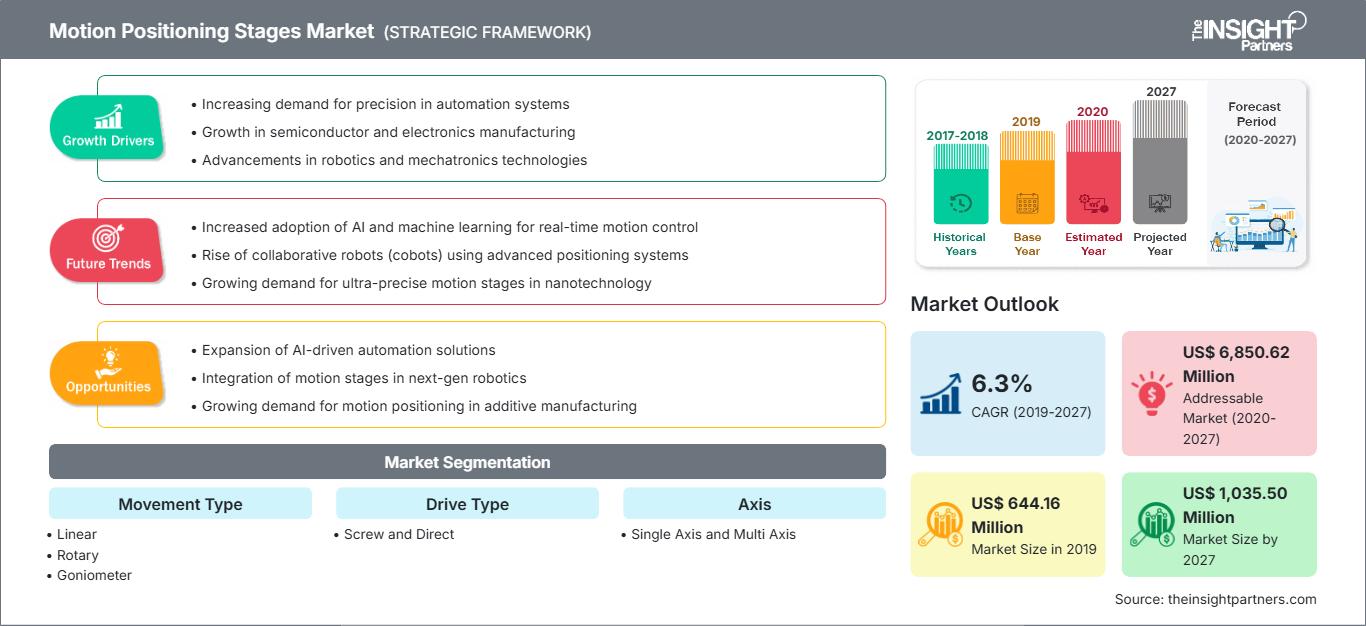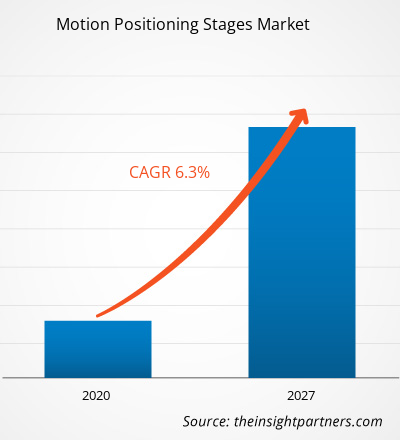Il mercato delle piattaforme di posizionamento e movimentazione è stato valutato a 644,16 milioni di dollari nel 2019 e si prevede che raggiungerà i 1.035,50 milioni di dollari entro il 2027; si prevede una crescita a un CAGR del 6,3% dal 2020 al 2027.
Le attività di posizionamento e movimentazione includono l'assemblaggio, la produzione di semiconduttori, i sistemi di ispezione, la lavorazione laser dei materiali o la produzione additiva. Le attività menzionate sono alcune delle attività di automazione industriale che richiedono soluzioni robuste e affidabili. Precisione, elevata dinamica e riproducibilità esatta della posizione sono requisiti essenziali nell'automazione industriale. Nell'era dei continui sviluppi tecnologici, l'Industria 4.0 sta guadagnando sempre più slancio, guidando la tendenza dell'automazione industriale in tutti i settori. I requisiti menzionati possono essere soddisfatti quando la tecnologia di azionamento, la meccanica e l'elettronica di controllo di un sistema di posizionamento si integrano perfettamente. Questo aspetto continuerà ad alimentare la richiesta di piattaforme di posizionamento e movimentazione in diversi settori nei prossimi anni. Oltre alla crescita del posizionamento tramite movimento, il crescente utilizzo dell'automazione in settori manifatturieri diversificati come quello alimentare e delle bevande, dei semiconduttori, dell'elettronica e dell'automotive sta crescendo in modo esponenziale. La crescente domanda di produzione di precisione nei settori di tutto il mondo è un altro fattore che stimola il posizionamento tramite movimento. Tutti gli aspetti sopra menzionati stanno guidando la crescita del mercato. Oltre a questi fattori, l'espansione del concetto di miniaturizzazione nel settore sanitario ed elettronico di consumo e il crescente utilizzo dell'Industria 4.0 stanno creando un impatto positivo sull'automazione industriale, influenzando di conseguenza la crescita del mercato. Tuttavia, a causa dell'elevata manutenzione e della durata limitata, potrebbero ostacolare la crescita del mercato delle fasi di posizionamento tramite movimento.
Il mercato delle fasi di posizionamento tramite movimento è ampiamente segmentato in cinque regioni principali: Nord America, Europa, APAC, MEA e SAM. In termini di quota di mercato, l'APAC ha dominato il mercato globale delle piattaforme di posizionamento nel 2019, seguita da Europa e Nord America. Nella regione del Nord America, la presenza diffusa di aziende produttrici di piattaforme di posizionamento come Aerotech Inc., Parker Hannifin e Newport Corporation contribuisce all'adozione più rapida di queste piattaforme nei settori di utilizzo finale. L'Europa è un altro mercato cruciale per la futura crescita del mercato delle piattaforme di posizionamento nel periodo di previsione. Finlandia, Germania, Francia e Regno Unito sono alcuni dei paesi chiave che stanno assistendo a una forte crescita in vari settori manifatturieri. Questo aspetto alimenterà la domanda di piattaforme di posizionamento nella regione europea. Inoltre, la regione vanta anche la presenza di aziende affermate nei settori automobilistico, sanitario e farmaceutico, che sono importanti utilizzatori di automazione industriale. Questo aspetto contribuirà all'adozione di piattaforme di posizionamento in Europa. In termini di crescita, si prevede che l'APAC sarà la regione in più rapida crescita, con un impressionante CAGR del 7,6% tra il 2020 e il 2027. L'APAC comprende diverse economie in via di sviluppo come Cina, India, Vietnam e altri paesi del sud-est asiatico, nonché economie sviluppate come Giappone e Australia. Le industrie manifatturiere nei paesi asiatici stanno crescendo a un ritmo esponenziale, il che favorirà la penetrazione dell'Industria 4.0. Grazie all'utilizzo della Quarta Rivoluzione Industriale per semplificare i processi produttivi, l'uso di piattaforme di posizionamento in movimento nelle economie asiatiche sta crescendo a un ritmo impressionante. Inoltre, l'economia asiatica è nota per la sua solida industria dell'elettronica di consumo e dei semiconduttori, che contribuisce ulteriormente alla crescente adozione di piattaforme di posizionamento in movimento. Anche i paesi del Medio Oriente e dell'Asia sudorientale stanno assistendo all'adozione dell'Industria 4.0, l'automazione industriale, che si prevede guiderà la crescita futura di questo mercato nei prossimi anni. Inoltre, la pandemia di COVID-19 sta colpendo le industrie di tutto il mondo e si prevede che l'economia globale subirà il colpo più duro nel 2020 e probabilmente anche nel 2021. L'epidemia ha creato notevoli sconvolgimenti in vari settori, come l'elettronica e l'industria. aziende manifatturiere operanti nei settori dei semiconduttori, dell'automotive, della difesa, dei dispositivi medici e in altri settori.
Personalizza questo rapporto in base alle tue esigenze
Potrai personalizzare gratuitamente qualsiasi rapporto, comprese parti di questo rapporto, o analisi a livello di paese, pacchetto dati Excel, oltre a usufruire di grandi offerte e sconti per start-up e università
Mercato delle fasi di posizionamento del movimento: Approfondimenti strategici

-
Ottieni le principali tendenze chiave del mercato di questo rapporto.Questo campione GRATUITO includerà l'analisi dei dati, che vanno dalle tendenze di mercato alle stime e alle previsioni.
Approfondimenti di mercato basati sul tipo di movimento
Gli stadi di posizionamento vengono utilizzati nei sistemi di controllo del movimento, che offrono funzionalità avanzate per posizionare la macchina in determinate operazioni. Gli sviluppi negli stadi di posizionamento migliorano i loro componenti meccanici e consentono di eseguire movimenti con precisione e sincronizzare comandi di assi complessi. Possono offrire diversi tipi di movimento, come lineare, rotativo e goniometrico. Il tipo lineare si muove in linea retta e solitamente è impilato l'uno sull'altro per consentire la corsa in molteplici direzioni. Un tipo di movimento rotativo generalmente ruota al centro. Il goniometrico ruota attorno a un punto nello spazio; si muove seguendo un arco anziché una linea retta. Sono utilizzati in numerose applicazioni, come macchine per il taglio laser, automazione e movimentazione industriale. Inoltre, progressi tecnologici come l'emergere di stadi di posizionamento digitali probabilmente aumenteranno la domanda di stadi di posizionamento nel prossimo futuro.
Approfondimenti di mercato basati sul tipo di azionamento
In base al tipo di azionamento, il mercato è segmentato in a vite e diretto. In genere, nella tecnologia di azionamento diretto magnetico vengono installati due tipi di motori lineari brushless: motori lineari con nucleo in ferro e motori lineari ironless. I motori ironless stanno riscontrando una domanda di mercato relativamente maggiore nel controllo del movimento di precisione, poiché offrono un funzionamento fluido e sono quindi preferiti per le applicazioni di controllo del movimento di precisione. Numerose aziende sono fortemente impegnate nell'offerta di motori a trasmissione diretta.
Lo sviluppo del prodotto è la strategia comunemente adottata dalle aziende per espandere il proprio portafoglio prodotti. Parker Hannifin Corporation, MISUMI Corporation, Newport Corporation, Physik Instrumente (PI) GmbH & Co. KG. e Aerotech Inc, tra gli altri, sono i principali attori che implementano strategie per ampliare la base clienti e acquisire una quota significativa nel mercato globale degli stadi di posizionamento, il che a sua volta consente loro di mantenere il proprio marchio. Ecco alcuni dei recenti sviluppi chiave:
- Nel 2019, MISUMI Group Inc. ha fondato il "Naka-Nihon Ryutsu Center" (Centro Logistico del Giappone Centrale) nella regione di Chubu per rafforzare l'affidabilità e la rapidità delle consegne. Questo terzo sito logistico in Giappone supporta ulteriormente la rapidità delle consegne nella regione di Tokai e nelle prefetture limitrofe.
- Nel 2019, Parker Hannifin Corporation ha acquisito LORD Corporation per creare un'organizzazione integrata con solide competenze in scienza dei materiali, elettrificazione e offerta di prodotti aerospaziali altamente complementari.
Mercato delle fasi di posizionamento del movimento
Le tendenze regionali e i fattori che influenzano il mercato delle piattaforme di posizionamento in movimento durante il periodo di previsione sono stati ampiamente spiegati dagli analisti di The Insight Partners. Questa sezione illustra anche i segmenti e la geografia del mercato delle piattaforme di posizionamento in movimento in Nord America, Europa, Asia-Pacifico, Medio Oriente e Africa, America meridionale e centrale.
Ambito del rapporto di mercato sulle fasi di posizionamento del movimento
| Attributo del rapporto | Dettagli |
|---|---|
| Dimensioni del mercato in 2019 | US$ 644.16 Million |
| Dimensioni del mercato per 2027 | US$ 1,035.50 Million |
| CAGR globale (2019 - 2027) | 6.3% |
| Dati storici | 2017-2018 |
| Periodo di previsione | 2020-2027 |
| Segmenti coperti |
By Tipo di movimento
|
| Regioni e paesi coperti |
Nord America
|
| Leader di mercato e profili aziendali chiave |
|
Il posizionamento del movimento mette in scena la densità degli attori del mercato: comprendere il suo impatto sulle dinamiche aziendali
Il mercato dei sistemi di posizionamento in movimento è in rapida crescita, trainato dalla crescente domanda degli utenti finali, dovuta a fattori quali l'evoluzione delle preferenze dei consumatori, i progressi tecnologici e una maggiore consapevolezza dei vantaggi del prodotto. Con l'aumento della domanda, le aziende stanno ampliando la propria offerta, innovando per soddisfare le esigenze dei consumatori e sfruttando le tendenze emergenti, alimentando ulteriormente la crescita del mercato.

- Ottieni il Mercato delle fasi di posizionamento del movimento Panoramica dei principali attori chiave
- Lineare
- Rotativo
- Goniometro
Per tipo di azionamento
- A vite
- Diretto
Per asse
- Asse singolo
- Multiasse
Per tipo di cuscinetto
- Cuscinetto ad aria
- Cuscinetto meccanico
Per carico
- 0-20 kg
- 21-50 kg
- 51-100 kg
- 101-140 kg
- Oltre 140 kg
Per applicazione
- Biotecnologia
- Laser Taglio
- Automazione
- Movimentazione industriale
- Altro
Profili aziendali
- Aerotech Inc.
- Dover Motion
- Edmund Optics Inc.
- MISUMI Corporation
- Newport Corporation
- Optimal Engineering Systems, Inc.
- OWIS GmbH
- Parker Hannifin Corporation
- Physik Instrumente (PI) GmbH & Co. KG.
- STANDA LTD
- Analisi storica (2 anni), anno base, previsione (7 anni) con CAGR
- Analisi PEST e SWOT
- Valore/volume delle dimensioni del mercato - Globale, Regionale, Nazionale
- Industria e panorama competitivo
- Set di dati Excel
Report recenti
Testimonianze
Motivo dell'acquisto
- Processo decisionale informato
- Comprensione delle dinamiche di mercato
- Analisi competitiva
- Analisi dei clienti
- Previsioni di mercato
- Mitigazione del rischio
- Pianificazione strategica
- Giustificazione degli investimenti
- Identificazione dei mercati emergenti
- Miglioramento delle strategie di marketing
- Aumento dell'efficienza operativa
- Allineamento alle tendenze normative






















 Ottieni un campione gratuito per - Mercato delle fasi di posizionamento del movimento
Ottieni un campione gratuito per - Mercato delle fasi di posizionamento del movimento